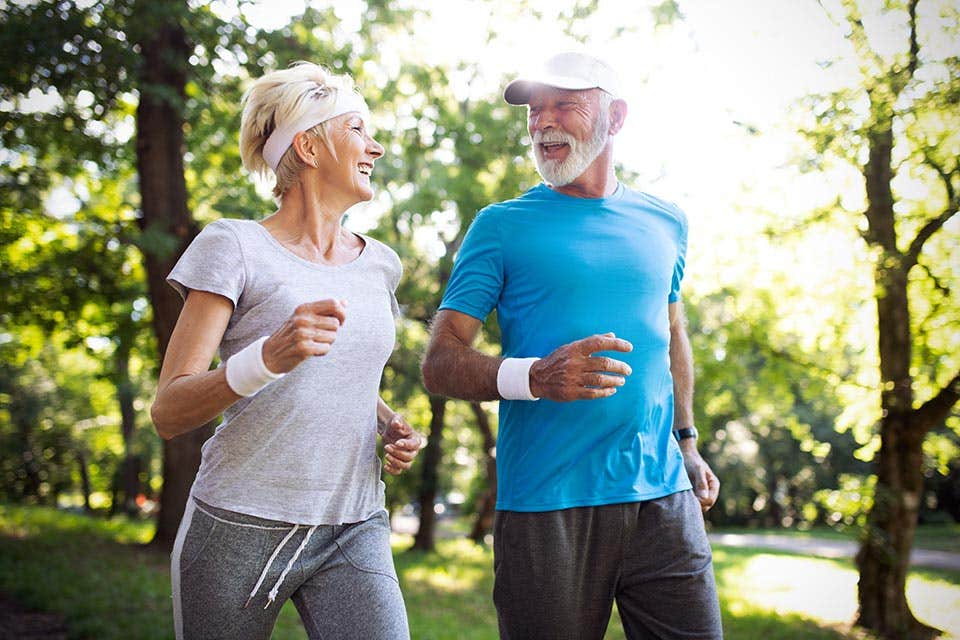Researchers identify how exercise preserves physical fitness during aging
Proven to protect against a wide array of diseases, exercise may be the most powerful anti-aging intervention known to science.

[Jan. 8, 2023: Chloe Meck, Joslin Diabetes Center]
Proven to protect against a wide array of diseases, exercise may be the most powerful anti-aging intervention known to science. (CREDIT: Creative Commons)
Proven to protect against a wide array of diseases, exercise may be the most powerful anti-aging intervention known to science. However, while physical activity can improve health during aging, its beneficial effects inevitably decline. The cellular mechanisms underlying the relationship among exercise, fitness and aging remain poorly understood.
In a paper published in the Proceedings of the National Academy of Sciences, researchers at Joslin Diabetes Center investigated the role of one cellular mechanism in improving physical fitness by exercise training and identified one anti-aging intervention that delayed the declines that occur with aging in the model organism. Together, the scientists’ findings open the door to new strategies for promoting muscle function during aging.
“Exercise has been widely employed to improve quality of life and to protect against degenerative diseases, and in humans, a long-term exercise regimen reduces overall mortality,” said co-corresponding author T. Keith Blackwell, MD, PhD, a senior investigator and section head of Islet Cell and Regenerative Biology at Joslin. “Our data identify an essential mediator of exercise responsiveness and an entry point for interventions to maintain muscle function during aging.”
That essential mediator is the cycle of fragmentation and repair of the mitochondria, the specialized structures, or organelles, inside every cell responsible for producing energy.
Related Stories:
Mitochondrial function is critical to health, and disruption of mitochondrial dynamics the cycle of repairing dysfunctional mitochondria and restoring the connectivity among the energy-producing organelles — has been linked to the development and progression of chronic, age-related diseases, such as heart disease and type 2 diabetes.
“As we perceive that our muscles undergo a pattern of fatigue and restoration after an exercise session, they are undergoing this mitochondrial dynamic cycle,” said Blackwell, who is also acting section head of Immunobiology at Joslin. “In this process, muscles manage the aftermath of the metabolic demand of exercise and restore their functional capability.”
Blackwell and colleagues — including co-corresponding author Julio Cesar Batista Ferreira, PhD, Institute of Biomedical Sciences, University of Sao Paulo — investigated the role of mitochondrial dynamics during exercise in the model organism C. elegans, a simple, well-studied microscopic worm species frequently used in metabolic and aging research.
AMPK, a metabolic regulator that senses low energy availability and controls mitochondrial dynamics, is needed for exercise to maintain physical fitness with age and can recapitulate this exercise benefit. (CREDIT: PNAS)
Recording wild type C. elegans worms as they swam or crawled, the investigators observed a typical age-related decline in physical fitness over the animals’ 15 days of adulthood. The scientists also showed a significant and progressive shift toward fragmented and/or disorganized mitochondria in the aging animals. For example, they observed in young worms on day 1 of adulthood, a single bout of exercise induced fatigue after one hour. The 60-minute session also caused an increase in mitochondrial fragmentation in the animals’ muscle cells, but a period of 24 hours was sufficient to restore both performance and mitochondrial function.
In older (day 5 and day 10) worms, the animals’ performance did not return to baseline within 24 hours. Likewise, the older animals’ mitochondria underwent a cycle of fragmentation and repair, but the network reorganization that occurred was reduced compared to that of the younger animals.
AMPK, a metabolic regulator that senses low energy availability and controls mitochondrial dynamics, is needed for exercise to maintain physical fitness with age and can recapitulate this exercise benefit. (CREDIT: PNAS)
“We determined that a single exercise session induces a cycle of fatigue and physical fitness recovery that is paralleled by a cycle of the mitochondrial network rebuilding,” said first author Juliane Cruz Campos, a postdoctoral fellow at Joslin Diabetes Center. “Aging dampened the extent to which this occurred and induced a parallel decline in physical fitness. That suggested that mitochondrial dynamics might be important for maintaining physical fitness and possibly for physical fitness to be enhanced by a bout of exercise.”
In a second set of experiments, the scientists allowed wild type worms to swim for one hour per day for 10 consecutive days, starting at the onset of adulthood. The team found that — as in people — the long-term training program significantly improved the animals’ middle-aged fitness at day 10, and mitigated the impairment of mitochondrial dynamics typically seen during aging.
AMPK, a metabolic regulator that senses low energy availability and controls mitochondrial dynamics, is needed for exercise to maintain physical fitness with age and can recapitulate this exercise benefit. (CREDIT: PNAS)
Finally, the researchers tested known, lifespan-extending interventions for their ability to improve exercise capacity during aging. Worms with increased AMPK — a molecule that is a key regulator of energy during exercise which also promotes remodeling of mitochondrial morphology and metabolism — exhibited improved physical fitness. They also demonstrated maintenance of, but not enhancement of, exercise performance during aging. Worms engineered to lack AMPK exhibited reduced physical fitness during aging as well as impairment of the recovery cycle. They also did not receive the age-delaying benefits of exercise over the course of the lifespan.
“An important goal of the aging field is to identify interventions that not only extend lifespan but also enhance health and quality of life,” said Blackwell, who is also a professor of genetics at Harvard Medical School. “In aging humans a decline in muscle function and exercise tolerance is a major concern that leads to substantial morbidity. Our data point towards potentially fruitful intervention points for forestalling this decline -- most likely along with other aspects of aging. It will be of great interest to determine how mitochondrial network plasticity influences physical fitness along with longevity and aging-associated diseases in humans.”
Additional authors included Takafumi Ogawa of Joslin Diabetes Center; Luiz Henrique Marchesi Bozi (co-first author) and Edward Chouchani of Dana-Farber Cancer Institute; Barbara Krum, Luiz Roberto Grassmann Bechara, Nikolas Dresch Ferreira, Gabriel Santos Arini, Rudá Prestes Albuquerque of University of Sao Paulo; Annika Traa of McGill University; Alexander M. van der Bliek of David Geffen School of Medicine at University of California, Los Angeles; Afshin Beheshti of NASA Ames Research Center; and Jeremy M. Van Raamsdonk of Harvard Medical School.
For more science and technology stories check out our New Discoveries section at The Brighter Side of News.
Note: Materials provided above by Joslin Diabetes Center. Content may be edited for style and length.
Like these kind of feel good stories? Get the Brighter Side of News' newsletter.
Joseph Shavit
Head Science News Writer | Communicating Innovation & Discovery
Based in Los Angeles, Joseph Shavit is an accomplished science journalist, head science news writer and co-founder at The Brighter Side of News, where he translates cutting-edge discoveries into compelling stories for a broad audience. With a strong background spanning science, business, product management, media leadership, and entrepreneurship, Joseph brings a unique perspective to science communication. His expertise allows him to uncover the intersection of technological advancements and market potential, shedding light on how groundbreaking research evolves into transformative products and industries.



